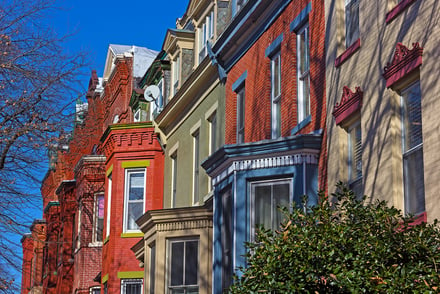Because of its longevity and flexibility of design, in Washington, DC, brick has been a material of choice in the building of residential and commercial structures since the colonial period. Genuine clay brick – made from clay and shale - has a documented history of durability and performance. Historically appropriate restoration techniques and materials preserve the structural integrity and historical value of the buildings.
Owners and fans of historic DC brick homes are familiar with the exterior brickwork that conveys a rich sense of history and adds to the value of the real estate. Less familiar is a performance history that explains the choice of brick.
Brick’s Unsurpassed Durability…Then AND Now
Because of its ability to withstand harsh elements, including fire, brick was selected early in America as a favored building material. Here are some of the reasons brick is still the material of choice:
Fire protection:
- More than two centuries ago, row houses in DC were required to have party walls built of brick or stone.
- In the nineteenth century, several American cities, including Baltimore, Chicago, Denver, Portland, Maine, and St. Louis, responded to devastating fires by adopting and often mandating the wide usage of brick in local building codes.
- Today brick is one of the few building materials whose wall systems attain a one hour fire rating without incorporating other fire-resistant materials.
High wind and harsh weather protection:
- Brick was often used in lighthouse construction. The Cape Hatteras Light, the tallest brick lighthouse in America, was completed in 1870 and is still in service today.
- A 2004 study showed that homes built with brick offer significantly more protection from wind-blown debris than homes built with vinyl or fiber-cement siding. In fact, the tests showed that even homes with a brick veneer exceed hurricane building code standards.
- In 2009, a study funded by the National Science Foundation showed that buildings constructed with brick veneer/concrete masonry can resist category D earthquakes without collapse.
Unique Flexibility in Design
Whether serving as a load-bearing structure in historical buildings or as a veneer in many of today’s new structures, brick’s modular shape and size give it superior design flexibility. With new manufacturing techniques customers have more color and texture options than ever. The historic classic look can be replicated by making new brick, often using historically appropriate techniques and materials, that matches the brick found in America's most treasured historic homes.
When your historic brick home needs repair, contact masonry contractors in Washington, DC that have experience and expertise with traditional materials and techniques. New work that complements the original quality of your home will preserve its historical value with the attention to historically appropriate materials.
Source: An Overview of the American Brick Industry
Renaissance Development, a leader in brick restoration and historic preservation, specializes in the restoration of a historic brick building’s mortar joints using traditional methods (tuckpointing) and materials. Contact us for a free site visit and project quote.
Tags:
Historic PreservationAug 22, 2014 10:14:00 AM



